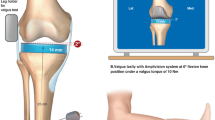Abstract
Introduction
The outcomes of 106 total knee arthroplasties implanted using a soft tissue balancing surgical technique at one surgical centre were used to assess the accuracy maintaining the knee’s original joint line (JL). The aim of the study was to determine whether there is a shift of the presumed joint line after surgery.
Materials and methods
Preoperative and post-operative radiographs were compared to determine any changes in the articulation height. The preoperative distance of the fibular head to the natural joint line was measured and compared with the post-operative measurement of the fibular head to the femoral articulation line (measured on the radiograph and defined as Rxmm). Based on the actual medio-lateral dimension of the tibial metal back, the measured difference (RXmm) could be converted into true distances (in mm). The Blackburn–Peel index was assessed as an additional outcome prior to and following surgery.
Results
Preoperatively, the average distance from the fibular head to the joint line was 15.1 Rxmm (SD 4.3) while the post-surgical distance was 15.5 Rxmm (SD 5.6). The average deviation of the post-surgical JL in relation to the original JL amounted to 0.4 Rxmm (SD 3.7). The average deviation of the joint line converted into the true distance was −0.3 mm (with a range of −5.9 mm in distal direction to + 8.3 mm in the proximal direction). Valgus position appeared to generate rather a shift in proximal direction whereas varus deformity favours a shift in distal direction. Seven patients exhibited a deviation of more than 5 mm in either the distal or proximal direction. All of the patients of this subgroup had a preoperative anatomical abnormality including a severe malalignment, serious bone destruction or had previously undergone a high tibial osteotomy.
Conclusion
An exact reconstruction of the natural Joint Line is achievable when using the described soft tissue balancing surgical technique with the posterior cruciate ligament (PCL) retaining prosthesis design used in this series.



Similar content being viewed by others
References
Blackburne J, Peel T (1977) A new method of measuring patellar height. J Bone Joint Surg Br 59:241
Carpenter CW, Cummings JF, Grood ES, Leach D, Paganelli JV, Manley MT (1994) The influence of joint line elevation in total knee arthroplasty. Am J Knee Surg 4:164–167
Chao EY, Neluheni EV, Hsu RW, Paley D (1994) Biomechanics of malalignment. Orthop Clin North Am 25:379–386
Chiu KY, Ng TP, Tang WM, Yau WP (2002) Review article: knee flexion after total knee arthroplasty. J Orthop Surg (Hong Kong) 10:194–202
Cope MR, O’Brien BS, Nanu AM (2002) The influence of the posterior cruciate ligament in the maintenance of joint line in primary total knee arthroplasty: a radiologic study. J Arthroplasty 17:206–208
Dennis DA, Komistek RD, Colwell CE Jr, Ranawat CS, Scott RD, Thornhill TS, Lapp MA (1998) In vivo anteroposterior femorotibial translation of total knee arthroplasty: a multicenter analysis. Clin Orthop 356:47–57
Emodi GJ, Callaghan JJ, Pedersen DR, Brown TD (1999) Posterior cruciate ligament function following total knee arthroplasty: the effect of joint line elevation. Iowa Orthop J 19:82–92
Estupinan JA, Bartel DL, Wright TM (1998) Residual stresses in ultra-high molecular weight polyethylene loaded cyclically by a rigid moving indenter in nonconforming geometries. J Orthop Res 16:80–88
Figgie HE III, Goldberg VM, Heiple KG, Moller HS 3rd, Gordon NH (1986) The influence of tibial-patellofemoral location on function of the knee in patients with the posterior stabilized condylar knee prosthesis. J Bone Joint Surg Am 68:1035–1040
Goldberg VM, Figgie HE III, Figgie MP (1989) Technical considerations in total knee surgery. Management of patella problems. Orthop Clin North Am 20:189–199
Grelsamer RP (2002) Patella baja after total knee arthroplasty: is it really patella baja? J Arthroplasty 17:66–69
Kawamura H, Bourne RB (2001) Factors affecting range of flexion after total knee arthroplasty. J Orthop Sci 6:248–252
Kraus S (2002) Outcome nach weichteilorientierter Implantation der “balanSys-Knieendoprothese”. In: Fakultät der Medizin, Medizinische Hochschule Hannover
Laskin RS (1986) RMC total knee replacement. A review of 166 cases. J Arthroplasty 1:11–19
Martin JW, Whiteside LA (1990) The influence of joint line position on knee stability after condylar knee arthroplasty. Clin Orthop 259:146–156
Mihalko WM, Krackow KA (1999) Posterior cruciate ligament effects on the flexion space in total knee arthroplasty. Clin Orthop 360:243–250
Partington PF, Sawhney J, Rorabeck CH, Barrack RL, Moore J (1999) Joint line restoration after revision total knee arthroplasty. Clin Orthop 367:165–171
Ritter MA, Montgomery TJ, Zhou H, Keating ME, Faris PM, Meding JB (1999) The clinical significance of proximal tibial resection level in total knee arthroplasty. Clin Orthop360:174–181
Rouvillain JL, Kanor M, Favuto M, Catonne Y, Dupont P, Delattre O, Pascal-Mousselard H (1999) Sagittal changes induced by knee arthroplasty: a radiologic study. Rev Chir Orthop Reparatrice Appar Mot 85:450–457
Ryu J, Saito S, Yamamoto K, Sano S (1993) Factors influencing the postoperative range of motion in total knee arthroplasty. Bull Hosp Jt Dis 53:35–40
Scuderi GR, Insall JN (1992) Total knee arthroplasty. Current clinical perspectives. Clin Orthop 276:26–32
Shoji H, Solomonow M, Yoshino S, D’Ambrosia R, Dabezies E (1990) Factors affecting postoperative flexion in total knee arthroplasty. Orthopedics 13:643–649
Singerman R, Heiple KG, Davy DT, Goldberg VM (1995) Effect of tibial component position on patellar strain following total knee arthroplasty. J Arthroplasty 10:651–656
Wright TM, Bartel DL (1986) The problem of surface damage in polyethylene total knee components. Clin Orthop 205:67–74
Yoshii I, Whiteside LA, White SE, Milliano MT (1991) Influence of prosthetic joint line position on knee kinematics and patellar position. J Arthroplasty 6:169–77
Acknowledgments
The statistical analysis and the work of D.H. Pfluger was supported financially by the manufacturer Mathys Bettlach AG.
Author information
Authors and Affiliations
Corresponding author
Rights and permissions
About this article
Cite this article
Wyss, T.F., Schuster, A.J., Münger, P. et al. Does total knee joint replacement with the soft tissue balancing surgical technique maintain the natural joint line?. Arch Orthop Trauma Surg 126, 480–486 (2006). https://doi.org/10.1007/s00402-006-0171-0
Received:
Published:
Issue Date:
DOI: https://doi.org/10.1007/s00402-006-0171-0




